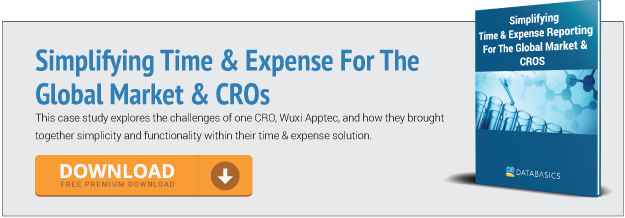
Four Things For CROs To Think About When Choosing Time & Expense
Choosing CRO Time & Expense
CROs (Contract Research Organizations) and the life sciences industry are growing faster than ever. With more opportunity for this steady growth, however, it introduces more challenges for the accounting group and billing team to handle the changes. This is where time and expense comes in. As the source of data for revenue and billability, time and expense has to keep data flowing and coming in from the field.
For CROs and life sciences companies, implementing proven time and expense solutions should be part of their strategy for getting back to core business. These are the top four areas CROs should consider when choosing a time and expense solution:
1) capturing all the details for effective billing
Capturing time and expenses for both employees and sub-contractors is critical for CROs to stay competitive and profitable. Because they have different WBS (Work Breakdown Structures) and bill rates, capturing all the details depends on the type of skills or employee resources that they put into their projects.
For instance, on some CRO projects, their customers do require their hours to be captured as time in/time out intervals or elapsed time, depending on how the contract pricing is structured. Other groups within the same organization might require their hours to be captured as semi-monthly, weekly, bi-weekly, or even daily. As you can see, it is important to have a time system that can accommodate these changes in one system.
In another example regarding expense reporting, receipts can be captured for the specific project. There are cases in which contracts require that these receipts are captured electronically. That's where it's important for the system to be able to provide receipts that match the customer invoice.
2) increasing utilization
Utilization is a critical component of labor. When you can allocate a particular number of hours to a specific WBS, it’s easier to monitor billable activity as it’s entered in real time through reporting and dashboards. Access to this level of data allows managers to forecast their billability and also adjust their project plans based on the hours collected.
For instance, let’s say that two employees are assigned to a particular project. Amy has worked 40 hours during the first week of the project. Jack has worked 20 hours on the first week of the project. But, then he's requested time off in the future. However, both should be working full-time on the project. Being able to monitor this data in real time gives you the opportunity to make corrections so that next week, you know that one is working and the second one is off. All in all, you can increase utilization.
Related Article: Can Your Back End Handle A CRO Acquisition Or Merger?
3) getting the big picture or the exact answer
As a CRO manager or member of the C-suite, you need both ends of the spectrum of data: the big picture and the most exact answer. One consideration to make is not only reporting capability, but also the ability to integrate with existing systems. Because time and expense is the source of data that feeds other systems in real time, you can get a full picture of what's going on in the field.
Being able to budget both time and expense against projects is important for getting a full overview on your budget versus actual in both your expenses and hours. For example, let's say that a contract comes in that only allows $5000 in travel per month and only budgeted up to 7680 hours for one year for four resources. It's important to be able to set up a budget for both the travel and hours and compare the actuals to budgeted expenses and hours.
4) Access Anywhere, Anytime
CROs need a mobile time and expense solution. That’s because they might have a large, global workforce of both employees and sub-contractors. Both groups should have the ability to provide their hours and expenses anywhere anytime.
Globalization is standard now. CROs are no different than the worldwide market, so they need features like multi-currency, multi-language, and VAT support.
Specifically, CROs need a tool to help them roll-up bill-back across countries and companies. For CROs in particular, acquisitions can be a consistent part of their business. That means that they need to be adaptable enough to accommodate new acquisitions. Let’s say that a CRO based in the U.S. is acquiring a new company, but that new company is in Canada. A future-proof solution needs to support that new Canadian company’s tax requirements and WBS in addition to its end user base’s language and currency.
In conclusion
To sum up, CROs should look for a solution that acts as a single instance for world-wide operations and can be rapidly deployed with minimal training.
Learn more about how DATABASICS can help CROs solve their biggest time and expense challenges using the expert solutions that have worked for other CROs. You can also get details on the solutions DATABASICS innovated to meet one CRO's needs in our free PDF case study.
For more information on the DATABASICS CRO & Life Sciences solutions, contact us, or call (800) 599-0434.
DATABASICS provides cloud-based, next generation Expense Reporting, P-Card Management, Timesheet & Leave Management, and Invoice Processing automation. Specializing in meeting the most rigorous requirements, DATABASICS offers the highest level of service to its customers around the world.
DATABASICS is relied upon by leading organizations representing all the major sectors of the global economy: financial services, healthcare, manufacturing, research, retail, engineering, non-profits/NGOs, technology, federal contractors, and other sectors.
Connect with DATABASICS: LinkedIn, Twitter, and YouTube. DATABASICS is headquartered in Reston, VA.
Subscribe to our blog
Recent Posts
Posts by Topics
- Expense Management Software (125)
- DATABASICS (69)
- Time Tracking Software (45)
- Leave Management System (26)
- P-Cards (9)
- Home Healthcare (8)
- Government Contractors (7)
- Nonprofit Organizations (7)
- International Development (6)
- Receipt Management (6)
- Advanced OCR (2)
- CROs (2)
- Staffing Agencies (2)
- Vendor Invoice Management (2)
- Audit Management Software (1)
- Construction (1)
- Field Service Management (1)
- Integration (1)
- Microsoft Dynamics (1)
- Oracle NetSuite (1)
- Partnerships (1)
- Professional Services (1)
Read on

DATABASICS In Review: 2025's Top Innovations & Most Popular Content
Read Now
Time & Expense Year-End Preparation & New Year Kickoff To-Do List
Read Now
Combating AI-Generated Receipt Fraud with Spend Control
Read NowIRS Mileage Rate 2026 Predictions: Trends, History, EV Costs, and How Companies...
Read Now
DATABASICS Wins Silver In Best In Biz Awards 2025: Celebrating Excellence In...
Read Now
Why DATABASICS Time & Expense Is Becoming the Central Hub for Enterprise ERP,...
Read Now
Subscribe to Our Blog
Subscribe to our blog and get the latest in time tracking and expense reporting news and updates.
